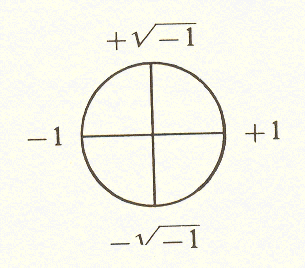Symbolic Algebra Basics
Symbolic algebra serves as a tool to calculate A.C. phenomena.
Invented by Charles P. Steinmetz.
Definition
a + jb = E = 1
Where:
± a, cos θ, the active/power factor (% horizontal component, x-axis)± b, sin θ, the reactive/induction factor (% vertical component, y-axis)jis the distinguishing indexEis a variable that has a active and reactive part (magnetic effect, EMF, in this case)
Rules:
- If
a + jb = 0, thena = 0andb = 0
j what?
The definition of j is as follows, this is the imaginary unit:
j = √ -1
j ^ 0 = + 1
j ^ 1 = + j
j ^ 2 = - 1
j ^ 3 = - j
How to use
What we’re actually doing is combination by the parallelogram law.
We’re looking for the hypothenuse.
a + jb = Math.sqrt(
Math.pow(a, 2) +
Math.pow(b, 2)
)
Phase angle
// tan θ = b / a
θ = arctan(b / a)
a + jb = cos θ + sin θ
Coordinate System
The following uses an example phase angle of 0º,
which means that cos θ will be 1:
(a + jb) * j ^ 0 = a + jb # (+1, 0) + 1 no rotation
(a + jb) * j ^ 1 = ja - b # (0, -1) - √-1 advance 90º
(a + jb) * j ^ 2 = -a - jb # (-1, 0) - 1 reverse, 180º rotation
(a + jb) * j ^ 3 = -ja + b # (0, +1) + √-1 advance 270º

Or in different terms:
a + jb = Math.sqrt( a ^ 2 + b ^ 2 )
ja - b = Math.sqrt( a ^ 2 - b ^ 2 )
- a - jb = Math.sqrt( - a ^ 2 - b ^ 2 )
-ja + b = Math.sqrt( - a ^ 2 + b ^ 2 )
This can be altered. For example, you can choose a different starting position, by rotating it, or you could go in the opposite direction. When going in the other direction, a different symbol is usually used, for example, j is forwards and k is backwards.
Operations
Addition
(a + jb) + (c + jd)
# Process
= a + jb + c + jd
= a + c + jb + jd
# Result
= (a + c) + j (b + d)
Subtraction
(a + jb) - (c + jd)
# Process
= a + jb - c - jd
= a - c + jb - jd
# Result
= (a - c) + j (b - d)
Multiplication
(a + jb) * (c + jd)
# Process
= (a * c) + (a * jd) + (jb * c) + (jb * jd)
= ac + ajd + cjb + jbjd
= ac + j * ad + j * cb + j^2 * bd
= ac + j (ad + cb) + j^2 * bd
= (ac + j^2 * bd) + j (ad + bc)
# Use rule defined above: j ^ 2 = - 1
= (ac + (-1 * bd)) + j (ad + bc)
= (ac + (-bd)) + j (ad + bc)
# Result
= (ac - bd) + j (ad + bc)
Division
(a + jb) / (c + jd)
# TODO